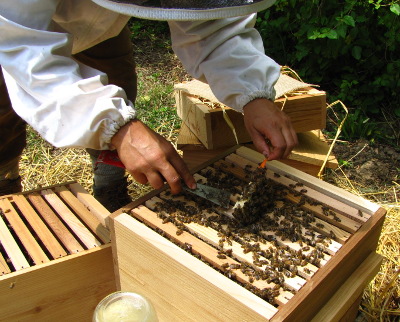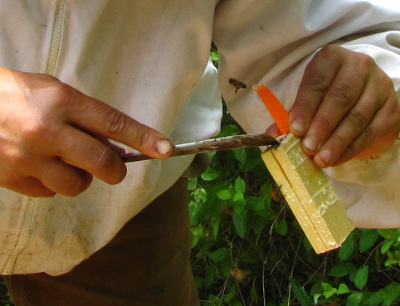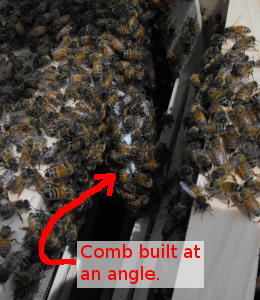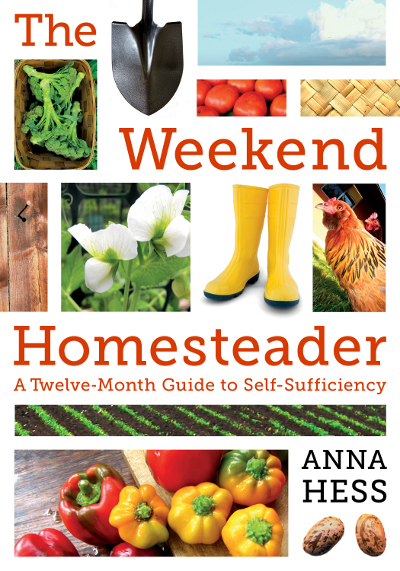
What to do after installing your package of bees
 After installing
a package of bees
into your new hive, you can sit back and relax...for a couple of
days. Most beekeepers recommend that you reopen the hive after
two to three days to make sure the queen has escaped from her cage,
removing the cork from the non-candy end and letting her run out if
not. I've usually had to help the queen escape, so you probably
will too --- just work over the hive and be extra careful that the
queen doesn't fly away or fall into the grass. After she's been
released, take the queen cage away with you rather than leaving it in
the hive (where bees will build funny comb
After installing
a package of bees
into your new hive, you can sit back and relax...for a couple of
days. Most beekeepers recommend that you reopen the hive after
two to three days to make sure the queen has escaped from her cage,
removing the cork from the non-candy end and letting her run out if
not. I've usually had to help the queen escape, so you probably
will too --- just work over the hive and be extra careful that the
queen doesn't fly away or fall into the grass. After she's been
released, take the queen cage away with you rather than leaving it in
the hive (where bees will build funny comb  off it) or around the hive
(where the queen pheremones still on the cage could make your workers
think she's leaving the hive).
off it) or around the hive
(where the queen pheremones still on the cage could make your workers
think she's leaving the hive).
As one of our readers
wrote, the other important followup task is to feed, feed, feed.
Even if you're trying to keep bees as naturally as possible, a new
package is the one instance where you really do need to feed your bees
since they require that sustenance to draw out comb and nurture
babies. I
asked readers for advice on what to feed our bees, and the best answer I got
was that it's safest to simply feed a new package sugar
water --- only give  honey
to bees from the same colony that made that honey (which you clearly
can't do with a package). As for how long to feed, it sounds like
the colony will need 6 to 8 weeks to get new workers flying around and
searching for nectar, so you may want to continue to feed your bees for
that long. Other people stop feeding as soon as the bees
start to producing capped frames of honey.
honey
to bees from the same colony that made that honey (which you clearly
can't do with a package). As for how long to feed, it sounds like
the colony will need 6 to 8 weeks to get new workers flying around and
searching for nectar, so you may want to continue to feed your bees for
that long. Other people stop feeding as soon as the bees
start to producing capped frames of honey.
Finally, if you're using
foundationless frames (nearly always in a top bar or Warre hive and sometimes also in a
Langstroth hive), it's important to make sure those first combs are
built straight. Bees line up future combs of wax parallel to the
first one they build, so if that one is crooked, your whole hive will
be full of crooked comb. Beekeepers will either cut out a bad
piece of wax or correct its orientation to get the bees off to a good
start.

Now you're ready for the
really hard part --- leaving your bees alone! We'll see how long
I can go before the urge to look into my Warre hive becomes unbearable.
Don't
miss my
paperback, full of
48 fun and easy projects to help you embark on your homesteading
journey without becoming overwhelmed.
| This post is part of our Bee Package lunchtime series.
Read all of the entries: |
Want more in-depth information? Browse through our books.
Or explore more posts by date or by subject.
About us: Anna Hess and Mark Hamilton spent over a decade living self-sufficiently in the mountains of Virginia before moving north to start over from scratch in the foothills of Ohio. They've experimented with permaculture, no-till gardening, trailersteading, home-based microbusinesses and much more, writing about their adventures in both blogs and books.
Want to be notified when new comments are posted on this page? Click on the RSS button after you add a comment to subscribe to the comment feed, or simply check the box beside "email replies to me" while writing your comment.
- Remove comment
